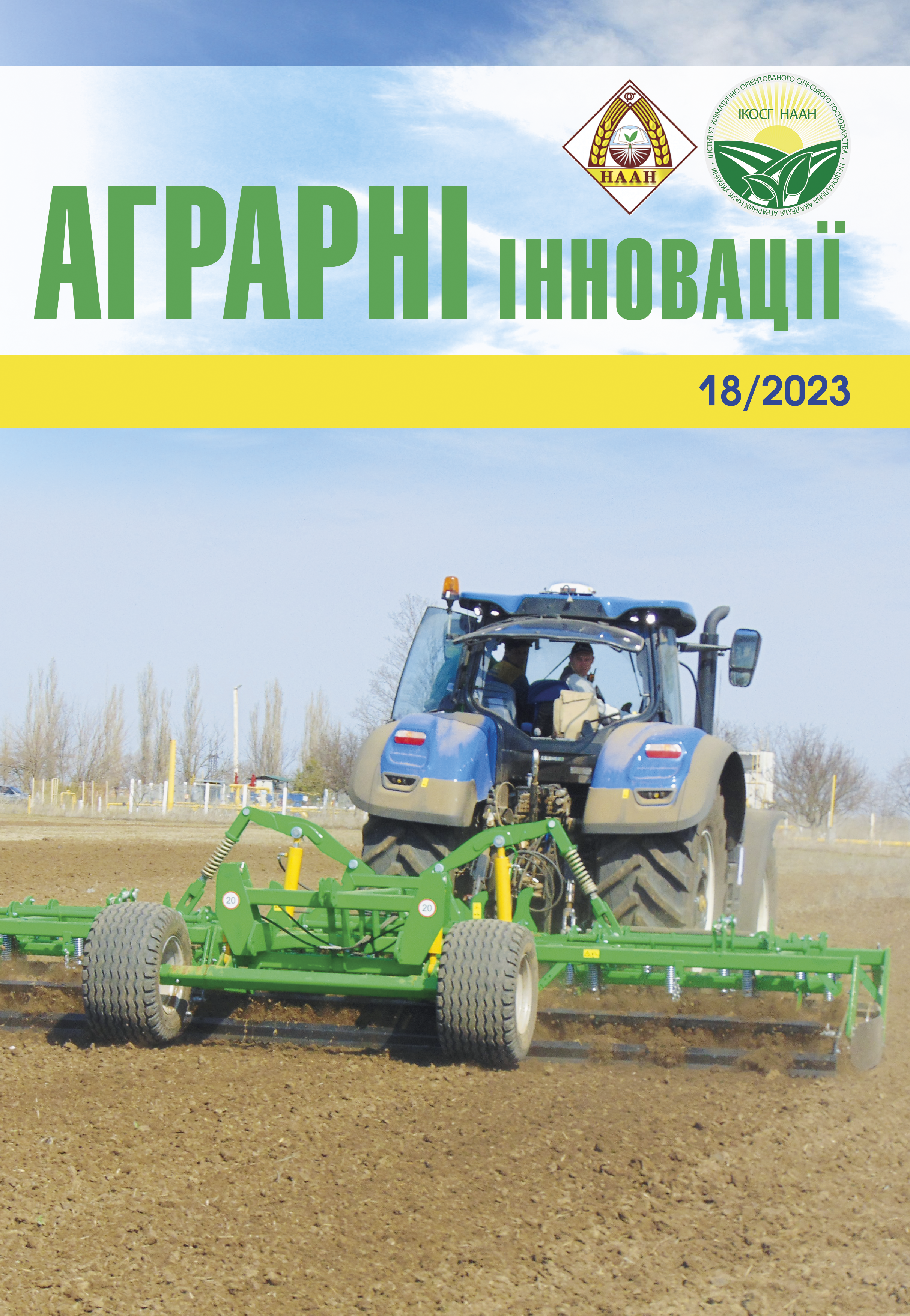THE EFFECT OF BIOLOGICAL PLANT PROTECTION ON SUNFLOWER PRODUCTIVITY UNDER IRRIGATION CONDITIONS IN SOUTHERN UKRAINE
Abstract
Perpose. To determine the impact of biological plant protection on the productivity of sunflower hybrids under irrigation conditions in the south of Ukraine. Methods. A set of general scientific methods and approaches of empirical and theoretical knowledge is applied: abstractlogical, statistical, modeling, generalization, two-factor field experiment. Results. During the entire vegetation period, significant differences were noted between hybrids and options for the use of biological preparations to protect plants from diseases according to the duration of the vegetation period. The highest values of this indicator – 129–132 days – were found in the Rimi hybrid using haupsin and Agat-25k seed treatment preparations. The growing season decreased by 17.2–21.7% when growing the yason hybrid without biological plant protection. During the formation of the basket, the maximum positive effect of the drug Agat–25k on the height of the plants of all studied hybrids was manifested. In the flowering phase, the difference between the options for seed treatment with biological preparations decreased to 3.3–14.5%, but the advantage of Agat–25k remained. According to factor a, the Rimi hybrid formed the highest height – on average 3.5–6.9% more than other hybrids. The largest indicators of the area of the assimilation surface at the level of 43.9–49.5 thousand m2/ha were observed in the rimi hybrid with treatment of sunflower seeds with the biological preparation Agat–25k. On average, according to the field experiment, in the phase of basket formation, the collection of dry matter was 0.61 t/ha, in the flowering phase, this indicator increased by 2.5 times (1.49 t/ha), and in the phase of full seed maturity, it reached the highest values - 3.53 t/ha, which was 2.4 times more than in the previous phase of development. Starting from the initial stages of organogenesis, the advantage of using Agat–25k biological preparation for pre-sowing seed treatment was evident, most of all for the cultivation of rr64e71 and Rimi hybrids. It was determined that on average for 2016–2018 and on average for factor A (hybrid), the maximum seed yield at the level of 3.17 t/ha was formed by the Rimi hybrid. According to the second studied factor (B – biological preparation), the advantage of the biological preparation Agat–25k was manifested in all studied sunflower hybrids. The РR64E71 hybrid had the best stress resistance -1.82. Genetic flexibility (2.83–3.17) was the highest РR64E71 and Rimi hybrids. The Rimi hybrid had the lowest variability (v = 14.8%). The breeding value at the maximum level – 2.00 was manifested in the variant with the Rimi hybrid. Conclusions. In field experiments, observation of sunflower plants made it possible to establish differences in the onset of phenological phases of development, as well as the difference and duration of interphase periods, growth dynamics, photosynthetic surface formation, accumulation of dry matter and yield in individual hybrids depending on the use of biological preparations to protect plants from pathogens.
References
2. Ткаліч І. Д., Ткаліч І. Ю., Кохан П. О. Які культури виснажують ґрунт більше? Пропозиція. 2014. № 1. С. 30–34.
3. Базалій В. В., Добровольський А. В. Наукові можливості підвищення ефективності виробництва продукції соняшника. Таврійський науковий вісник. 2015. № 93. С. 3–6.
4. Кириченко В. В., Коломацька В. П., Макляк К. М., Сивенко В. І. Виробництво соняшнику в Україні: стан і перспективи. Вісник ЦНЗ АПВ Харківської області. 2010. Вип. № 7. С. 281–287.
5. Маркова Н. Агроекологічні аспекти вирощування гібридів соняшнику в умовах Південного Степу України. Вісник аграрної науки Причорномор'я. 2014. № 1. С. 85–98.
6. Schmid M. W., Hahl T., Van Moorsel S. J., Wagg C., De Deyn G. B., Schmid B. Feedbacks of plant identity and diversity on the diversity and community composition of rhizosphere microbiomes from a long-term biodiversity experiment. Mol. Ecol. 2019. Vol. 28(4). P. 863–878.
7. Roy M. A., Sharma S., Braunius K. P., Ajmani A. M., Keyser A. D., Butler C. S., Reckhow D. A., Dhankher O. P. Lime-treated urine improves sunflower growth without shifting soil bacterial communities. Applied Soil Ecology. 2022. Vol. 178. 104575.
8. Saritha M., Tollamadugu The Status of Research and Application of Biofertilizers and Biopesticides: Global Scenario. Recent Developments in Applied Microbiology and Biochemistry. 2019. P. 195–207.
9. Nafady N. A., Hashem M., Hassan E. A., Ahmed H.A.M., Alamri S. A. The combined effect of arbuscular mycorrhizae and plant-growth-promoting yeast improves sunflower defense P. against Macrophomina phaseolina diseases. Biological Control. 2019. Vol. 138. 104049.
10. Babalola O. O., Alawiye T. T., Lopez C. M. R. Shotgun metagenomic sequencing data of sunflower rhizosphere microbial community in South Africa. Data Brief. 2020. Vol. 31. P. 1–6.
11. Kour D., Rana K. L., Yadav A. N., Yadav N., Kumar M., Kumar V., Vyas P., Dhaliwal H. S., Saxenae A. K. Microbial biofertilizers: Bioresources and eco-friendly technologies for agricultural and environmental sustainability. Biocatalysis and Agricultural Biotechnology. 2020. Vol. 23. 101487.
12. Домарацький Є. О., Козлова О. П. Вплив біологічних фунгіцидів на рівень ураження гібридів соняшника патогенною мікрофлорою. Podilian Bulletin: Agriculture, Engineering, Economics. 2018. № 29. С.9–16.
13. Шкатула Ю. М. Вплив біологічних препаратів на продуктивність соняшнику. The scientific heritage (Budapest, Hungary). 2020. № 44. P. 17–23.
14. Швайківський Б. Я., Лопушняк В. І., Киричук Р. Г. Регулятори росту рослин – ефективний засіб підвищення якості продукції сільськогосподарських культур. Сільський господар. 2000. № 5–6. С. 3–4.
15. Біднина І. О., Влащук О. С., Козирєв В. В., Томницький А. В. Ефективність сумісного застосування добрив та мікробних препаратів при вирощуванні сільськогосподарських культур на півдні України. Зрошуване землеробство. 2013. № 60. С. 54–56.
16. Коваленко А. М., Коваленко О. А., Пілярський В. Г. Урожайність культур короткоротаційної сівозміни за умов застосування мікробних препаратів у Південному Степу. Аграрні інновації. 2020. № 1. С. 52–56.
17. Ушкаренко В. О., Вожегова Р. А., Голобородько С. П., Коковіхін С. В. Методика польового досліду (Зрошуване землеробство): навчальний посібник. Херсон: Грінь Д.С., 2014. 448 с.
18. Ушкаренко В. О., Вожегова Р. А., Голобородько С. П., Коковіхін С. В Статистичний аналіз результатів польових дослідів у землеробстві. Херсон: Айлант, 2013. 381 с.






